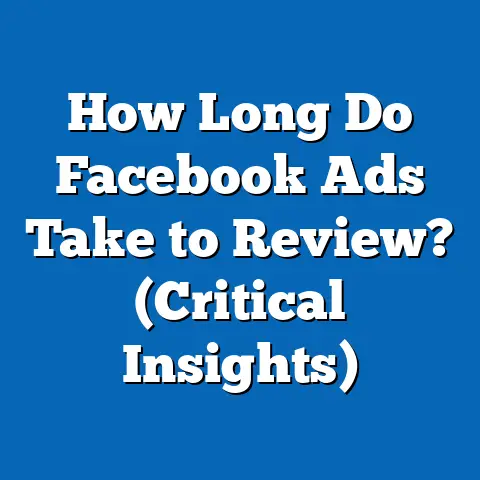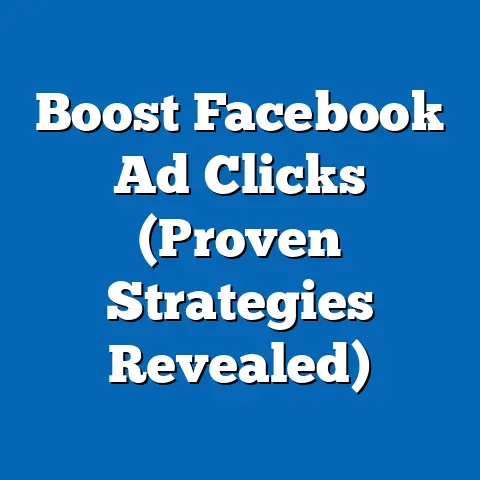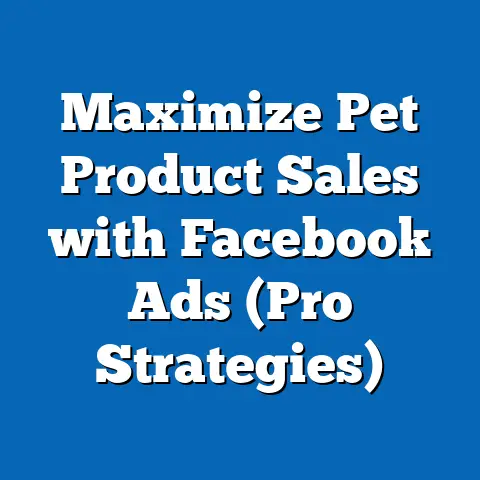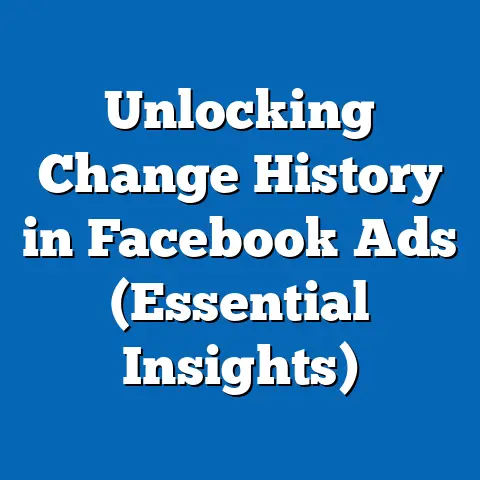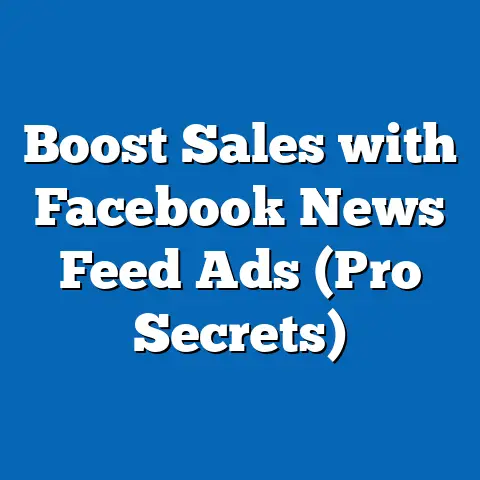Maximize Reach with Google & Facebook Ads (Pro Strategies)
In today’s dynamic digital landscape, advertising is no longer a luxury but a necessity for businesses aiming to thrive and expand their reach. Among the myriad of advertising platforms available, Google Ads and Facebook Ads stand out as powerhouses, offering unparalleled opportunities to connect with target audiences and drive meaningful results. What’s truly remarkable about these platforms is their accessibility. Gone are the days when digital advertising was solely the domain of tech-savvy experts. With user-friendly interfaces, comprehensive tutorials, and robust support resources, Google and Facebook Ads have democratized the advertising landscape, making it accessible even for beginners.
Understanding the Basics of Google and Facebook Ads
Before diving into advanced strategies, it’s crucial to lay a solid foundation by understanding the fundamentals of Google and Facebook Ads. While both platforms aim to connect businesses with potential customers, they operate in distinctly different ways.
Google Ads: Connecting with Intent
Google Ads, formerly known as Google AdWords, is an online advertising platform where advertisers bid to display brief advertisements, service offerings, product listings, or videos to web users. These ads appear primarily in the results of search engine results pages (SERPs) like Google Search and YouTube. The beauty of Google Ads lies in its ability to connect businesses with users who are actively searching for specific products or services. It’s about capturing intent.
Types of Google Ads:
- Search Ads: Text-based ads that appear on Google’s search results page when users search for relevant keywords.
- Display Ads: Visual ads that appear on websites within the Google Display Network (GDN), reaching a broad audience across the internet.
- Video Ads: Ads that appear on YouTube and other websites, allowing businesses to showcase their brand and products through engaging video content.
- Shopping Ads: Product listings that appear on Google’s search results page, providing users with detailed information about products, including price and availability.
Facebook Ads: Reaching Your Audience Where They Are
Facebook Ads, on the other hand, is a social media advertising platform that allows businesses to target users based on their demographics, interests, behaviors, and connections. Unlike Google Ads, which captures intent, Facebook Ads focuses on reaching users where they spend their time – on social media.
Types of Facebook Ads:
- Image Ads: Single-image ads that are visually appealing and can effectively capture audience attention.
- Video Ads: Engaging video ads that allow businesses to tell their story and showcase their products in a dynamic way.
- Carousel Ads: Ads that feature multiple images or videos in a single ad unit, allowing businesses to showcase multiple products or features.
- Collection Ads: Ads that feature a catalog of products, allowing users to browse and purchase directly from the ad.
- Lead Ads: Ads that allow businesses to collect leads directly from the ad, making it easy for potential customers to express interest in their products or services.
Audience Targeting: The Key to Success
Both Google and Facebook Ads offer robust audience targeting capabilities, allowing businesses to reach the right people with the right message.
- Google Ads: Targets users based on keywords, demographics, interests, and remarketing lists.
- Facebook Ads: Targets users based on demographics, interests, behaviors, connections, and custom audiences.
Complementary Platforms: A Cohesive Strategy
While Google and Facebook Ads operate differently, they can complement each other to create a cohesive advertising strategy. For example, you can use Google Ads to capture users who are actively searching for your products or services and then use Facebook Ads to retarget those users with personalized ads.
Takeaway: Understanding the basics of Google and Facebook Ads, including their distinct features, ad types, and audience targeting capabilities, is crucial for building a successful advertising strategy.
Crafting Effective Ad Campaigns
Now that we’ve covered the basics, let’s dive into the art of crafting effective ad campaigns that resonate with your target audience and drive results.
Setting Clear Goals: The Foundation of Success
Before launching any ad campaign, it’s essential to define your goals. What do you want to achieve with your advertising efforts? Are you looking to increase brand awareness, generate leads, drive sales, or something else? Setting clear goals will help you focus your efforts and measure your success.
Common Advertising Goals:
- Brand Awareness: Increasing awareness of your brand among your target audience.
- Lead Generation: Collecting leads from potential customers who are interested in your products or services.
- Sales: Driving sales of your products or services.
- Website Traffic: Driving traffic to your website.
- App Installs: Encouraging users to install your mobile app.
Researching and Defining Your Target Audience: Know Your Customer
Understanding your target audience is crucial for creating ads that resonate with them. Who are you trying to reach? What are their demographics, interests, and behaviors? Conducting thorough research and defining your target audience will help you create ads that speak directly to their needs and desires.
Tips for Defining Your Target Audience:
- Analyze Your Existing Customers: Look at your current customer base to identify common characteristics.
- Conduct Market Research: Gather data on your target market through surveys, interviews, and focus groups.
- Create Buyer Personas: Develop detailed profiles of your ideal customers, including their demographics, interests, behaviors, and pain points.
Writing Compelling Ad Copy: Speak Their Language
Your ad copy is your opportunity to grab your audience’s attention and convince them to take action. Write compelling ad copy that highlights the benefits of your products or services and speaks directly to your target audience’s needs and desires.
Tips for Writing Compelling Ad Copy:
- Use Strong Headlines: Your headline is the first thing people will see, so make it attention-grabbing and relevant.
- Highlight Benefits, Not Just Features: Focus on how your products or services will benefit your customers, rather than just listing their features.
- Use a Clear Call to Action: Tell people what you want them to do, such as “Shop Now,” “Learn More,” or “Sign Up.”
- Keep It Concise: Get to the point quickly and avoid using jargon or overly technical language.
High-Quality Visuals: A Picture is Worth a Thousand Words
Visuals play a crucial role in ad performance. Use high-quality images and videos that are visually appealing and relevant to your target audience. Your visuals should capture attention and convey your message effectively.
Tips for Using High-Quality Visuals:
- Use Professional Photography: Invest in professional photography to capture high-quality images of your products or services.
- Create Engaging Videos: Use video to tell your story and showcase your products in a dynamic way.
- Use Consistent Branding: Ensure that your visuals align with your brand’s overall aesthetic.
Examples of Successful Ad Campaigns: Learning from the Best
Analyzing successful ad campaigns can provide valuable insights into what works and what doesn’t. Look at examples of ads that have effectively captured audience attention and driven results. Pay attention to the ad copy, visuals, targeting, and overall strategy.
Example: A clothing retailer might run a Facebook ad featuring a stylish model wearing their latest collection. The ad copy could highlight the comfort and versatility of the clothing, while the targeting could focus on women aged 25-45 who are interested in fashion.
Takeaway: Crafting effective ad campaigns requires a combination of clear goals, thorough audience research, compelling ad copy, and high-quality visuals. By following these principles, you can create ads that resonate with your target audience and drive meaningful results.
Leveraging Advanced Targeting Techniques
Once you’ve mastered the basics of ad campaign creation, it’s time to explore advanced targeting techniques that can take your advertising efforts to the next level.
Lookalike Audiences: Expanding Your Reach
Lookalike audiences are a powerful tool on Facebook that allows you to reach new people who are similar to your existing customers. By uploading a customer list or using data from your website or app, Facebook can identify common characteristics among your best customers and create a lookalike audience of users who share those characteristics.
Benefits of Lookalike Audiences:
- Reach New Potential Customers: Expand your reach beyond your existing customer base.
- Target Highly Qualified Leads: Reach users who are more likely to be interested in your products or services.
- Improve Ad Performance: Increase your ad’s click-through rate and conversion rate.
Custom Intent Audiences: Capturing Specific Interests on Google
Custom intent audiences on Google Ads allow you to target users based on the specific keywords and websites they’ve been searching for or visiting. This allows you to reach users who are actively researching products or services similar to yours.
Benefits of Custom Intent Audiences:
- Target Highly Engaged Users: Reach users who are actively searching for your products or services.
- Improve Ad Relevance: Create ads that are highly relevant to your target audience’s interests.
- Drive Higher Conversion Rates: Increase your chances of converting potential customers.
A/B Testing: Refining Your Targeting
A/B testing, also known as split testing, involves creating multiple versions of your ads and testing them against each other to see which performs best. This allows you to refine your targeting and optimize your ad performance over time.
Tips for A/B Testing:
- Test One Variable at a Time: Focus on testing one variable at a time, such as the headline, image, or call to action.
- Use a Large Sample Size: Ensure that you have a large enough sample size to draw statistically significant conclusions.
- Track Your Results: Monitor your results closely and make adjustments based on the data.
Retargeting: Re-Engaging Your Audience
Retargeting involves showing ads to users who have previously interacted with your brand, such as visiting your website, watching a video, or adding items to their cart. This allows you to re-engage those users and encourage them to take the next step.
Tips for Retargeting:
- Segment Your Audience: Segment your audience based on their previous interactions with your brand.
- Create Personalized Ads: Create ads that are tailored to each segment’s specific interests and needs.
- Use a Limited Time Offer: Create a sense of urgency by offering a limited time discount or promotion.
Demographic and Psychographic Data: Personalization at Its Finest
Demographic data includes information such as age, gender, location, and income. Psychographic data includes information such as interests, values, and lifestyle. By combining demographic and psychographic data, you can create highly personalized ads that resonate deeply with your target audience.
Example: A luxury car brand might target affluent individuals aged 40-60 who are interested in golf, travel, and fine dining.
Takeaway: Leveraging advanced targeting techniques, such as lookalike audiences, custom intent audiences, A/B testing, retargeting, and demographic and psychographic data, can significantly improve your ad performance and drive better results.
Budgeting and Bidding Strategies
Effective budgeting and bidding strategies are crucial for maximizing your return on investment (ROI) and ensuring that you’re getting the most out of your advertising spend.
Setting a Realistic Budget: Know Your Limits
Before launching any ad campaign, it’s essential to set a realistic budget. How much can you afford to spend on advertising? Consider your business goals, target audience, and the potential ROI of your campaigns.
Factors to Consider When Setting Your Budget:
- Your Business Goals: What are you trying to achieve with your advertising efforts?
- Your Target Audience: How large is your target audience?
- Your Competition: What are your competitors spending on advertising?
- Your Conversion Rate: What is your average conversion rate?
- Your Average Order Value: What is your average order value?
Bidding Strategies: Maximizing Efficiency
Google and Facebook Ads offer a variety of bidding strategies to help you achieve your advertising goals.
- Cost-Per-Click (CPC): You pay each time someone clicks on your ad. This is a good option for driving traffic to your website.
- Cost-Per-Impression (CPM): You pay for every 1,000 impressions of your ad. This is a good option for increasing brand awareness.
- Target CPA: You set a target cost per acquisition (CPA) and the platform automatically adjusts your bids to achieve that target. This is a good option for driving conversions.
Tips for Choosing the Right Bidding Strategy:
- Consider Your Goals: What are you trying to achieve with your advertising efforts?
- Test Different Strategies: Experiment with different bidding strategies to see which performs best for your business.
- Monitor Your Results: Monitor your results closely and make adjustments based on the data.
Monitoring Ad Spend: Stay in Control
It’s crucial to monitor your ad spend regularly to ensure that you’re staying within your budget and getting the most out of your advertising dollars.
Tips for Monitoring Ad Spend:
- Set Daily or Weekly Budgets: Set daily or weekly budgets to limit your spending.
- Track Your Performance: Track your performance closely to see which campaigns are performing well and which are not.
- Adjust Your Bids: Adjust your bids based on performance metrics and ROI.
Takeaway: Setting a realistic budget and choosing the right bidding strategy are essential for maximizing your ROI and ensuring that you’re getting the most out of your advertising spend.
Monitoring and Analyzing Performance
Tracking and analyzing your ad performance is crucial for understanding what’s working and what’s not, and for making informed decisions to optimize your campaigns.
Key Performance Indicators (KPIs): Measuring Success
Key performance indicators (KPIs) are metrics that you can use to measure the success of your advertising campaigns.
Common KPIs:
- Click-Through Rate (CTR): The percentage of people who click on your ad after seeing it.
- Conversion Rate: The percentage of people who take a desired action after clicking on your ad, such as making a purchase or filling out a form.
- Return on Ad Spend (ROAS): The amount of revenue you generate for every dollar you spend on advertising.
- Cost Per Acquisition (CPA): The cost of acquiring a new customer through advertising.
- Impressions: The number of times your ad is shown to users.
- Reach: The number of unique users who see your ad.
Analytics Tools: Unveiling Insights
Google and Facebook Ads offer robust analytics tools that allow you to track your ad performance and gain valuable insights into your audience.
- Google Analytics: A web analytics service that tracks and reports website traffic.
- Facebook Analytics: A mobile and web analytics service that tracks user behavior on Facebook and other platforms.
Interpreting Data: Making Informed Decisions
Interpreting data and making informed decisions based on your findings is essential for optimizing your campaigns.
Tips for Interpreting Data:
- Look for Trends: Identify trends in your data to see what’s working and what’s not.
- Segment Your Data: Segment your data to see how different segments of your audience are responding to your ads.
- Compare Performance Over Time: Compare your performance over time to see how your campaigns are improving.
Takeaway: Monitoring and analyzing your ad performance is crucial for understanding what’s working and what’s not, and for making informed decisions to optimize your campaigns.
Remember, the key to effortless success with Google and Facebook Ads lies in understanding the nuances of each platform, setting clear goals, targeting the right audience, crafting compelling ad copy and visuals, and continuously monitoring and optimizing your campaigns.
Now it’s time to take action! Implement the pro strategies outlined in this article and witness the transformative effects on your business growth. Start your advertising journey today and unlock the full potential of Google and Facebook Ads.
I encourage you to share your own experiences with Google and Facebook Ads in the comments section below. Let’s create a community of learning and growth where we can all learn from each other’s successes and challenges. The power to maximize your reach is within your grasp, so start your advertising journey today and witness the incredible impact on your business!

